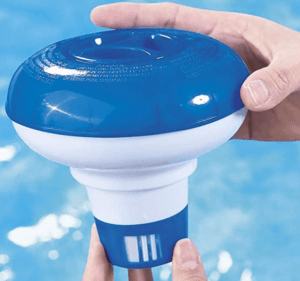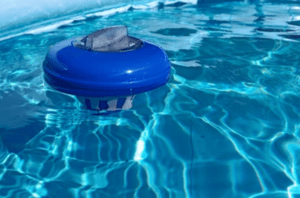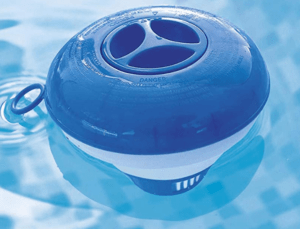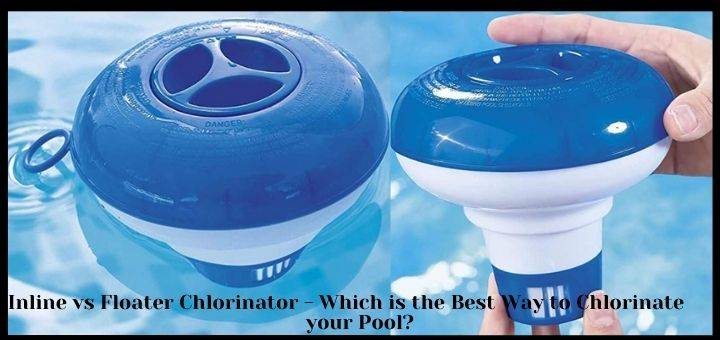Although a chlorine floater is a less expensive option, you are much better off using an Automatic Chlorinator to dispense chlorine throughout the pool. An Automatic Chlorinator is a great way to quickly and evenly distribute chlorine throughout the pool.
This is true when it comes time to open the pool for the season. Use to get as much chlorine into the system as possible, and there is no better way to do so than with an Automatic Chlorinator.
The difference between an inline, floater automatic chlorinator is that it forces chlorine into the pool whether it is needed or not, and it is already diluted by the time it enters the pool.
The 3-inch tabs that go into the floaters are heat released, which means the chemical is only released when it is needed, to make your chemicals last longer
A Floating Dispenser or an Automatic Chlorinator
The floating dispenser and the automatic chlorinator assist you with the dispensing of chlorine into the pool, giving you an easy time on the whole clean-up issue.
The chlorine comes in pukes which are fed into the floating dispenser and the automatic chlorinator and they proceed to release it into the pool in small amounts.
This article will give highlight the advantages of each. and a final verdict at the end of the post to let you know what is working for the pool.
Automatic Chlorinator

A small device that connects the filter and an outlet outside the pool is known as an automatic chlorinator. In the chamber, you insert chlorine tablets. As the tablet slowly dissolves in the chamber, you can control how much chlorine is dispensed with the filter’s outlet.
How does the automatic chlorinator work?
The pool has other machines that work in hand with the automatic chlorinator to ensure the pool is in great condition. The automatic chlorinator, the filters, and the pool pump all work in sync at all times to ensure the pool is maintained in good condition.
The great thing about the automatic chlorinator is that you are in control of the amount of chlorine that will be released into the pool and the rate. With the help of a valve on the automatic chlorinator, you could switch it off once its job is done.
Types of automatic chlorinator
Something to note about the automatic chlorinator is the fact that there are two kinds of automatic chlorinator; one being the off-line chlorinator and the other being the in-line chlorinator the difference between the two is how they are conjoined into the pool to release chlorine.
The off-line automatic chlorinator is drained into the pool from a different source, this gives you the power to have it uninstalled when not in use or install it when there is a need.
On the other hand, the in-line automatic chlorinators are found in the water return pipe of the pool and they are installed permanently, they cannot be uninstalled.
Maintenance

You will not have to break your back to keep the automatic chlorinators in good working order. The Olso outdoor automatic chlorinator had stopped working, and this was a quick and low-cost fix.
There is one thing you should do to have it in great condition; have the O-rings lubricated using the silicone lubricant and make sure to have the cap replaced on time.
Sure this is a little task compared to what other pool chlorinators will have you go through. You need to inspect the pipes to be sure there are no leaks of any kind as it could be dangerous to have chlorine spilling.
How to refill your automatic chlorinator
All the precautions are taken as stated by the manufacturer first before proceeding to have the chlorine pukes into the feeder pipes.
Once everything is set, proceed to have the cap on the automatic dispenser turn, when open give the fumes time to escape from the pipe then proceed to have the chlorine pucks into the feeder.
Kindly take the needed precautions to avoid any kind of accident. Have the pipes checked for any wear and fix it up in case of any damages. The inspections of the pool will have your pool in great condition all around years.
Best Chlorinator for In-ground Pools
Pros
Some of the things that made using an automatic chlorinator ideal for anyone with a backyard pool include the following;
The low maintenance
The maintenance that you will need for your automatic chlorinator is less expensive. You will only need to have the O-rings lubricated after feeding the chlorine pucks and replacing the cap which is way easy for maintenance.
The automatic chlorinator is simple to maintain because it is built into the pool and water passes through it before the pump and filter system.
The automatic chlorinator build-up structure will make the filter system last longer and perform better because the parts will be protected from chlorine damage.
With the automatic chlorinator, you can worry because your pool will receive continuous chlorine clean-up even when you are away; thus, you can say goodbye to any of the green algae families in your pool.
Safety measures

The automatic chlorinator being in-built makes it safe for everyone using the pool. The fixtures are done outside the swimming pool making it safe for children to play in the pool. This is unlike the floating chlorinators which pose a challenge when having toddlers in the pool.
Aesthetic
With the automatic chlorinator, you won’t have piped all over your pool, which is visually appealing. You will enjoy a clean pool without having the obstruction of pipes in your pool. With the installation of the automatic chlorinator, you will not see any pipes crossing your pool letting you enjoy an algae-free pool with no obstruction.
Ease of use
With the automatic chlorinator in place, all you have to do is sit and enjoy your clean pool. You will have to set the timer which will dictate and control the amount of chlorine that is released into the pool.
All you will have to worry about is the chlorine pucks as you have to refill from time to time to ensure your pool is well chlorinated at all times.
Installation
The automatic chlorinator allows you to pick between having it in-line or offline. Each of these options has its advantages as they all same a role in ensuring your pool is well disinfected at all times.
You could opt for the off-line whereby you could decide to have it plucked out when not in use, unlike the inline automatic chlorinator.
Cons
The installation
The installation of an inline automatic chlorinator could pose a challenge in the case of an already existing pool. When the pool pump and filter are already in place, it would be difficult to install.
Pricey
The automatic chlorinator is pricey and it will have you think of adding the chlorine to your pool water by yourself.
The installation and the purchase take up much of the expenses, aside from that you will need to have an engineer check on what was done to ensure there are no kinds of mishaps during the work. Failing to have the inspection done may cost you more in the long run, so that is not a cost you can avoid.
Repairs and maintenance
The two are things you cannot avoid having done. You need to have the pipes leading to the pool inspected from time to time. In the case of a leakage, you have to hire a professional to take care of the damages and have it fixed in record time to avoid further damage.
Awful experience
The pile-up of pressure and gas found in the pipes offers an unpleasant experience. The sad part is you cannot avoid refilling your chlorine pucks despite the fact the buildup gas will bust open once you remove the cap from the pipe. make sure to have your face away from the gas.
Buildup in the pipes
There are times buildup in pipes may be experienced brought about by gas blockage in the pipe. The blockage in the pipe will affect the amount of chlorine released into the water and you will not get value for your automatic chlorinator.
Insufficient chlorine released into your water will have your pool filled with algae without you realizing the problem.
Floating Chlorinator
The term floating is what this cup looks like in your pool with pucks of chlorine in it. It does its job while it stays afloat in your pool. The water in the pool simply goes through it and it is chlorinated keeping your pool safe all through.
Offline Chlorinator
If you own a pool and do not want to go through the hassle of a full-scale pool renovation, an offline chlorinator is the best option for you. If you use an offline chlorinator, you won’t have to worry about cutting a section of your pipe.
Another option is to simply drill a few holes in the PVC plumbing. Furthermore, an offline chlorinator is a space-saving option, especially if there is limited space for a pool chlorinator to be installed.
Inline Chlorinator
The PVC pipe is connected to an inline chlorinator. Water circulates through the chlorinator, dissolving the chlorine tablets and dispersing the appropriate amount of chlorine into the water.
However, when installing inline chlorinators, you would want this hard piped in during the construction of your pool or a pool restoration so that getting to the PVC for cutting is not a major job.
The chlorine pucks in your floating chlorinator get dissolved into the water creating an acidic environment for your pool killing the germs and leaving your pool safe and clean.
They do a great job of having your pool sanitized at all times. The kind of lifestyle you would wish to achieve for your pool will guide you on whether to go for the floating chlorinator or not.
Not pricey at all
You could purchase a floating chlorinator for as little as $$$ which is very cheap making it affordable for everyone with a pool. The price of the floating chlorinator beats the automatic chlorinator as much is not needed for the installation.
Easy to use
You will simply check the chlorine tablets in your floating cup-like structure once you have purchased your chlorinator and are at home. Water will pass through the cup as it floats around the pool.
The floating chlorinator has adjustable vents that allow the pool owner to control the amount of chlorine dispensed into the pool. You can easily use the cup during the off-season and when the pool reopens in the summer.
Aesthetic
You can select various colors to give your pool a theme that will make it look nice. The presence of vents on the floating chlorinator will require you to decide how much chlorine to release into the pool.
The design of the vents gives the chlorine dispenser a completely look different. Choose a dispensing cup that will be useful for your pool.
Cons
Amount of chlorine
I noticed that I needed to have chlorine in storage at all times. The dispensing cup will not hold large amounts of chlorine tablets and will need you to refill it now and then.
Aside from the amount of chlorine in question, filling up the cup will have you handling chlorine with your bare hands which is not good. Thoroughly clean up after that to avoid damage by chlorine on your skin.
Safety precautions
The floating cup in your pool is not a safe place for toddlers to swim. Curiosity will lead to children occasionally touching the cup, which is not recommended. The design of the floating cup will make them think of it as a toy, and they will focus on it.
Manual checkup
To ensure that you are getting enough chlorine dispensed into the pool, check with your floating cup every now and then to ensure that there are enough chlorine tablets to clean the pool.
If the chlorine tablets dissolve, you’ll need to replenish the supply by adding more tablets to the cup. The task is unpleasant, and you must face away from it to avoid exposing your face to the fumes that have accumulated in the cup over time. When refilling your cup, take the necessary precautions.
Exposure
Your floating chlorinator is made of plastic in order to do its work, which is to float in the pool and release chlorine.
The cup will be exposed to sunlight throughout, and due to the constant heat from the sun, the cup’s color will fade even if you use UV-resistant plastic material. In cases where the plastic material has FADED, it cracks after a few months. You may need to replace it.
CONCLUSION
A pool in your backyard is a great idea for the summer season because you will need to cool off from the heat. Maintaining a pool, whether above-ground or underground, necessitates regular cleaning and sanitization with the use of chemical feeders.
Depending on how much you are willing to spend on ensuring your pool remains clean off-season and in-season the two have very different price ranges. The floating chlorinator is inexpensive and simple to obtain, whereas the automatic chlorinator is more expensive.
The decision you make when purchasing between the two will entirely be based on the convenience you get from each of the chlorinators.
FAQS
What is the best way to chlorinate a pool?
You will benefit greatly from having a pool. Whether it is above ground or underground, you must still consider a reliable way to sanitize your pool both off and during the season. You have the option of periodically dispensing chlorine tablets into your pool.
You will require a reliable way to have the chlorine tablets in the pool to clean the water. The presence of an automatic chlorinator and a floating chlorinator will have you deciding on what will work best for your pool and what is most cost-effective for you.
Because it is not expensive, the floating chlorinator is a low-cost and dependable option for you. The vents on the cup allow you to control how much chlorine is released into the pool. On the other hand, we have the automatic chlorinator which allows you to set for chlorine to get released into the pool at a timer.
How long do pool chlorinators last?
If you’re looking for an excellent pool chlorinator, you are required to investigate how long it will last before you have to purchase it. it is important for you to understand then you make a decision.
With the proper precautions in place, a good floating chlorinator can last up to three years in the pool before needing to be replaced. It will need to be replaced due to wear and tear caused by the sun, as it floats and is constantly exposed to the sun.
In the first couple of years, UV rays will wear down the plastic, causing it to fade in color. If the necessary precautions are not taken, it will begin to crack after the second year.
You’ll have to keep an eye on the pipes all the time to make sure there aren’t any leaks. Pipe leaks can cause massive damage and cost you a lot of money. Your automatic chlorinator will last seven years if the pipes are in good shape and the valve is in perfect working order.
Are pool chlorinators worth it?
If you do not invest in a pool chlorinator, you will be exposed to dirty water every time you enter the pool. Your pool will be affected by algae, which you should avoid.
While sanitizing your pool, a good pool chlorinator will keep algae and other microorganisms at bay. Because your pool contains chlorine, you will spend less time maintaining it, allowing you to enjoy a clean pool.
Because the automatic chlorinator uses less chlorine, the right pool chlorinator will have you spending the least amount of money on chlorine granules.
Related Article:
- Best Chlorinator for In-ground Pools
- Best Automatic Chlorinator for In-ground Pools
- Guide Automatic Pool Chlorinators
- 15 Must-Have Products to Start Your Cozy Outdoor Kitchen - July 15, 2025
- 30 Cozy Outdoor Kitchen Ideas You Can Try in Any Backyard - July 14, 2025
- 27 Cozy Dark Bedroom Inspiration Ideas for Warm and Relaxing - July 13, 2025

